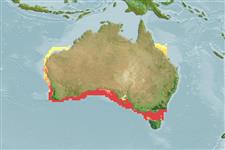Élasmobranches (requins et raies) (sharks and rays) >
Squatiniformes (Angel sharks) >
Squatinidae (Angel sharks)
Etymology: Squatina: Latin for skate, which angel sharks superficially resemble, presumably tautonymous with Squalus squatina Linnaeus 1758 (no species mentioned). (See ETYFish); australis: Latin for southern, referring to distribution along coast of southern Australia. (See ETYFish).
More on author: Regan.
Environment: milieu / climate zone / depth range / distribution range
Écologie
marin démersal; profondeur 15 - 256 m (Ref. 54902). Temperate; 18°S - 44°S, 113°E - 153°E (Ref. 54902)
Eastern Indian Ocean: southern Australia (including New South Wales).
Taille / Poids / Âge
Maturity: Lm ? range ? - ? cm
Max length : 152 cm TL mâle / non sexé; (Ref. 247)
Description synthétique
Morphologie | Morphométrie
Épines dorsales (Total): 0; Rayons mous dorsaux (Total): 0; Épines anales 0; Rayons mous anaux: 0. Numerous dark spots on lower lobe of caudal fin (Ref. 31369). Pectoral fins greatly enlarged, with broad triangular lobe extending forward from their bases on either side of the gill slits; pelvic fins enlarged and wing-like; caudal very short, nearly symmetrical but not lunate, its lower lobe slightly longer than the upper (Ref. 31369).
A common but little-known angelshark found on the continental shelf and uppermost slope, on or near the bottom (Ref. 247, 75154). Occurs from close inshore to 130 m depth (Ref. 31369, 6871). Feeds mainly on small fishes and crustaceans (Ref. 6871). Ovoviviparous (Ref. 247). Flesh is highly esteemed (Ref. 6871).
Life cycle and mating behavior
Maturité | Reproduction | Frai | Œufs | Fécondité | Larves
Ovoviviparous, embryos feed solely on yolk (Ref. 50449).
Compagno, L.J.V., 1984. FAO Species Catalogue. Vol. 4. Sharks of the world. An annotated and illustrated catalogue of shark species known to date. Part 1 - Hexanchiformes to Lamniformes. FAO Fish. Synop. 125(4/1):1-249. Rome, FAO. (Ref. 247)
Statut dans la liste rouge de l'IUCN (Ref. 130435)
Menace pour l'homme
Traumatogenic
Utilisations par l'homme
Pêcheries: intérêt commercial mineur
Plus d'informations
Taille/ÂgeCroissanceLongueur-poidsLongueur-longueurFréquences de longueursMorphométrieMorphologieLarvesDynamique des populations larvairesRecrutementAbondanceBRUVS
RéférencesAquacultureProfil d'aquacultureSouchesGénétiqueElectrophoresesHéritabilitéPathologiesTraitementNutrientsMass conversion
CollaborateursImagesStamps, Coins Misc.SonsCiguateraVitesseType de nageSurface branchialeOtolithesCerveauxVision
Outils
Articles particuliers
Télécharger en XML
Sources Internet
Estimates based on models
Preferred temperature (Ref.
123201): 14 - 20.4, mean 16 °C (based on 129 cells).
Phylogenetic diversity index (Ref.
82804): PD
50 = 0.5000 [Uniqueness, from 0.5 = low to 2.0 = high].
Bayesian length-weight: a=0.00676 (0.00293 - 0.01558), b=3.07 (2.88 - 3.26), in cm total length, based on LWR estimates for this Genus-body shape (Ref.
93245).
Niveau trophique (Ref.
69278): 4.0 ±0.66 se; based on food items.
Résilience (Ref.
120179): Faible, temps minimum de doublement de population : 4,5 à 14 années (Fec assumed to be <100).
Fishing Vulnerability (Ref.
59153): Very high vulnerability (90 of 100).
